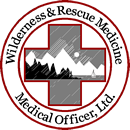Little Red Bumps
© 2010 Jeffrey E. Isaac, PA-C
I'm tapping out this news brief from 9 degrees north/ 146 degrees west on passage from the Marquesas to Hawaii. I was invited to join this ship for my emergency medical skills. The skipper is justifiably concerned about being able to stabilize severe injury or illness but what this crew really needs is a dermatologist."Little red skin bumps" is the most frequent complaint among my patient population of 37 students and staff aboard this sailing school vessel, now in the middle of her 3-week blue water voyage. I should not be surprised by the symptoms considering the close quarters, near adolescent age group, and unrelenting heat and humidity.
There are medical practitioners who spend their entire careers diagnosing and treating little red skin bumps. I am not one of them. To be at all effective in dealing with LRSB's, I have to fall back on basic principles and a little common sense. There is also the age-old medical axiom, "first, do no harm".
The skin, like any other body part, becomes inflamed when injured, infected, or exposed to an allergen or toxin. The result is little red bumps and the working diagnosis of "acute inflammatory process". Next, I need to figure out whether or not to worry about it, what's causing the inflammation and how to treat it. By the way, the term "acute" means recent onset - as opposed to "chronic" which refers to a long-standing problem. Contrary to popular opinion, acute does not necessarily mean serious.
I don't worry about LRSBs that might look bad, but feel fine. If the patient is not reporting pain, itching, fevers or chills, or other adverse symptoms, no treatment is necessary. You can try the typical remedies and see what works or just leave them alone and let a real dermatologist see them when you get ashore.
I get worried when the LRSB’s look bad and feel bad. Sometimes it’s a just-can't-get-to-sleep kind of itch and you only need to treat the symptoms. But real pain, especially when accompanied by regional swelling, redness, fever or general malaise is much more of a concern because it may indicate a skin infection or serious systemic disease.
With a little investigation the cause or inciting factor may become obvious. Study the distribution of the rash. Does it appear randomly everywhere, or does it favor certain areas like underarms, folds of skin, or the waistband of nylon shorts? Aboard this ship, I've noticed LRSB’s clustered under watchbands, sandal straps, and the elastic straps of clothing. It’s not too hard to imagine these areas remaining wet with sweat and more prone to irritation and possible infection.
Typical in the tropics where sweat glands are working overtime is folliculitis. This involves infection of obstructed glands causing some of the some of the LRSB’s to develop whiteheads, indicating the presence of pus. This type of infection is best treated by with oral antibiotics if widespread, topical antibiotics if localized.
Sometimes, the bumps are the symptoms of a localized allergic reaction, such as jellyfish stings or insect bites. These tend to come on fast and itch a lot, indicating a histamine release. Antihistamine medications are the treatment.
Common sense dictates that you try to change or eliminate the contributing factor when you can identify it. If warm and moist seems to be causing it, then cool and dry will cure it. Sweat less, wear less clothing or spend more time out of it, and stay clean.
You should be carrying an oral antibiotic aboard, preferably several different types. Cephalexin is a good choice for skin infection. It’s cheap and effective and does not cause a photosensitivity reaction with sunlight. You should augment this drug with a supply of trimethoprim/sulphamethoxizole which will treat MRSA, a form of strep that is resistant to the usual skin drugs. Suspect MRSA if an infection does not respond rapidly to cephalexin. A third choice would be ciprofoloxacin for treating rashes that seem associated with wet suits and rubber boots or doesn't respond to other antibiotics.
A systemic rash, which is evenly distributed over the body, is less likely to be caused or aggravated by something touching the skin. It is more likely to represent a systemic problem like an allergic reaction or the cutaneous manifestation of an internal infection like strep. You will need to treat the systemic problem to treat the rash.
As usual, I will add the disclaimer that the use of antibiotics and the diagnosis and treatment of anything that looks serious is best done with competent medical advice backed up by appropriate training.

